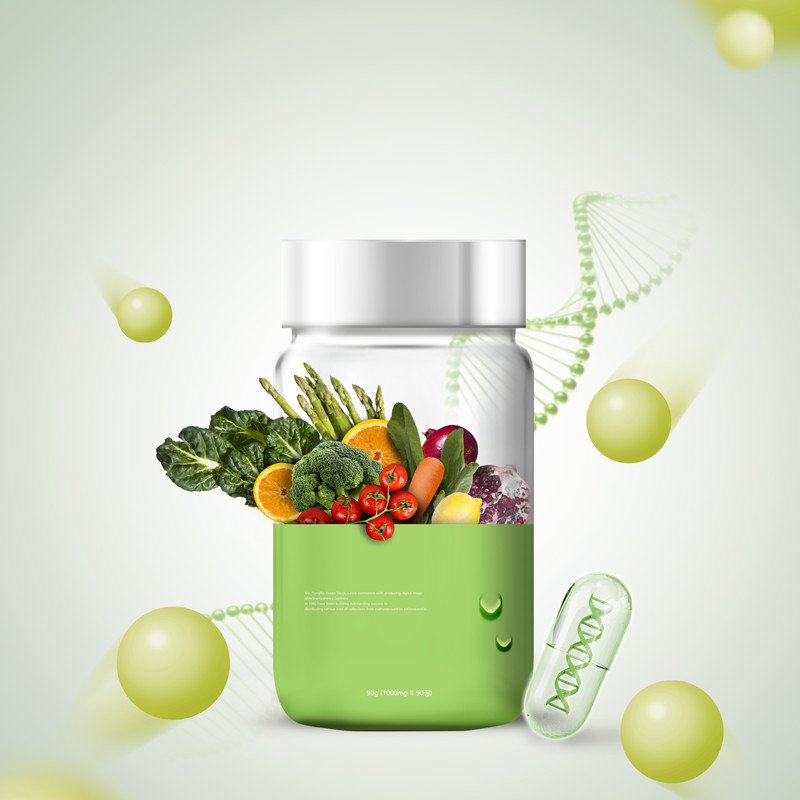According to the Nutrition Business Journal (NBJ) data, the global sales of dietary supplements in 2016 were US$121.2 billion, and it is expected to exceed US$150 billion in 2020. In 2016, the United States was the largest dietary supplement market, accounting for 34% of the global share, followed by China and Europe. From 2006 to 2016, the global share of China’s dietary supplements rose from 9.6% to 14.3%.
1. U.S. Dietary Supplements Market
According to NBJ statistics, in 2016, the United States was the world’s largest dietary supplement market. In 2017, its market share of dietary supplements reached US$43.2 billion, an increase of 5.1% from 2016. Among them, collagen products are very popular, with a growth rate of 30% and a market share of 98 million US dollars; mushrooms and fungi products have rapid growth, with a growth rate of 10.1% and a market share of 46 million US dollars.
American consumers have formed a habit of using dietary supplements
In 2016, there were 836 dietary supplement manufacturers in the U.S., supplying more than 60,000 dietary supplements and consuming 200 million people. The U.S. government has relatively loose regulations on dietary nutritional supplements. Therefore, the U.S. has a wide variety of products with complete functions, and the pace of innovation is fast.
From the product point of view, dietary supplements can be roughly divided into 13 categories, including sports nutrition, compound nutrients, herbal/traditional dietary supplements, coenzyme Q10, etc. According to the consumer survey report, the product categories that consumers use frequently are compound nutrients, vitamin D, calcium, fish oil, and probiotics. It is estimated that compound nutrients account for nearly 17% of all dietary supplement purchases and 40% of all vitamin and mineral supplement sales. Although vitamin/mineral supplements are still the most popular category among supplement users, the overall usage of herbal/botanical drugs has increased significantly in 2011-2016. In 2018, according to a consumer survey report, 41% of consumers surveyed claimed that they had taken herbal/physical medicines in the past 12 months, an increase of 13 percentage points from 2013. In particular, turmeric products are currently the second most popular dietary supplement in the herbal/plant category.

Complete offline sales channels
Consumers in the United States can purchase dietary supplements through natural products and specialty retail stores, mass-market retail, TV shopping and other media sales, medical staff sales, direct sales, online sales, and other channels. Among them, specialty retail stores accounted for the highest proportion of sales channels, accounting for 36% of the market, such as GNC, Vitamin Shoppe, and Vitamin World. Secondly, mass-market retail accounts for a higher share of sales, such as Walmart, Target, Costco, Sam’s, BJ WHOLESALE CLUB, etc., occupying the market Of 28%. It can be seen that the sales of dietary supplements in the United States mainly depend on the physical stores in specialty stores and mass markets.
The high proportion of U.S. adults taking dietary supplements
In 2018, the Council of Nutrition (CRN) survey found that 75% of American adults take dietary supplements, compared with 65% in 2009. The 2018 survey results also showed new trends in consumer behavior and product demand. The number of people using dietary supplements in the United States is still on the rise.
78% of American adults over 55 take dietary supplements, followed by 35-54 (77%) and 18-34 (69%). In 2018, 77% of American adults aged 35-54 took dietary supplements, an increase of 11 percentage points from before 2013; 42% took herbal/plant supplements, an increase from 37% in 2017 5%. Besides, 31% of supplement users in this age group believe that immune health is the primary reason for taking dietary supplements. 46% of supplement users over 55 take vitamin D. In addition, healthy aging (28%), heart health (29%), and bone health (31%) are the main reasons why elderly Americans take dietary supplements.
Significant growth in brain health products
According to NBJ’s statistics in 2018, NBJ analyzed and predicted the market development trends of brain health and cognitive impairment, anti-aging, and heart health. The size of the US brain health market in 2017 was 871 million U.S. dollars, and with the increase of the elderly population, the market size is expected to reach 1.04 billion U.S. dollars by 2021. The anti-aging market in the United States is 503 million U.S. dollars, and as consumers are concerned about anti-aging, the market size is expected to be close to 600 million U.S. dollars by 2021. In the US heart health market, sales in 2017 reached 2.638 billion U.S. dollars, and sales are expected to reach 3.188 billion U.S. dollars by 2021.
The characteristics of the US dietary supplement market are: First, it has a transparent and open regulatory mechanism. Through the regulatory mechanism, the government can supervise enterprises, and enterprises can improve their operations, and consumers have a very clear awareness and trust in the US regulatory mechanism. The second is a safe investment. Every year, American dietary supplement companies generally make large investments, and the benefits are also very considerable. The third is a mature new product. Every year, companies invest a lot of money in new product research and development. The fourth is mature sales channels. There are probably more than 30,000 dietary supplement stores in the United States for consumers to purchase. Fifth, the education level and trust of the consumer group. Because the US dietary supplement market has a very long history, and many professionals in the United States are committed to the popularization and promotion of dietary supplements, which are generally recognized by consumers.

2. Australian dietary supplement market
In 2017, the Australian nutrition and healthcare industry continued to prosper, with industrial output value reaching a record 4.9 billion Australian dollars, an increase of 2 billion Australian dollars in the past five years. According to analysis, export growth is the main driving force for the rapid development of the industry. More than 60% of Australian companies are engaged in export business, and China, New Zealand, Hong Kong, Japan, South Korea, and ASEAN are their main export markets. In 2018, the trade volume of nutrition and healthcare between China and Australia reached US$740 million, an increase of 57.5% year-on-year.
With the acceptance and widespread use of dietary supplements by Australian consumers, especially the increasing demand in overseas markets, the Australian dietary supplement industry is showing a rapid development trend and the industry continues to prosper. According to statistics, there were 82 nutrition and healthcare manufacturing companies in Australia in 2018. In terms of industry category, the largest scale is still vitamin and mineral products, with 2.77 billion Australian dollars; followed by sports nutrition, with a scale of 1 billion Australian dollars, and herbal products (including traditional products) ranked third, with 6.9 Billion Australian dollars, and the scale of weight control products has reached 430 million Australian dollars. The main sales channels of Australia’s nutritional and health products are mainly stored sales. The country’s 5,000 pharmacies, 3,500 supermarkets, and 500 health product stores account for 41%, 26%, and 25% of offline sales respectively. In terms of hot-selling categories, the top five categories with the fastest growth in 2018 are probiotics, propolis, calcium, chlorophyll, and cranberry products, with growth rates of 10.2%, 9.6%, 9.1%, 7.4%, and 6.9%, respectively.
According to Euromonitor’s statistics, in 2017, the well-known companies in the Australian dietary supplement industry were Swisse, Blackmores, Sanofi, Nashkell, Herbalife, Healthy World, etc. Among them, Swisse, Aojiabao, and Sanofi accounted for a larger share of 13.3%, 12.1%, and 7.2% respectively.
With the strong support of the government, Australian companies have seized the opportunity of the emergence of new Internet sales formats such as cross-border e-commerce, overseas shopping, and direct mail. With high-quality products and a good brand image, they quickly entered the Chinese market and became popular among consumers. A number of brand companies have risen rapidly. Swisse, Blackmores, and Healthcare have become well-known dietary supplement brands for Chinese consumers. Brand companies from various countries have also carried out in-depth cooperation with outstanding original design manufacturers (ODM) and OEM companies such as LIPA Pharmaceuticals (LIPA Pharmaceuticals) to develop and produce innovative products that lead the industry.
At present, China has become one of the important export markets for Australia’s dietary supplement products. According to statistics from the China Chamber of Commerce for Import and Export of Medicines and Health Products, China imported 670 million US dollars of dietary supplements from Australia in 2018, an increase of 60.8 year-on-year, and has surpassed the United States to become China’s largest source of imports. In 2014, four years ago, China’s imports from Australia were only 13 million U.S. dollars, accounting for 1.1% of total imports, ranking 16th. Australian companies take advantage of e-commerce to seize the development opportunities in the Chinese market, which is the key to their success. Secondly, Australia’s strict regulatory system and innovative regulatory concepts are the foundation for the development of the industry. Australia’s nutrition and healthcare industry has a globally recognized strict regulatory system. The Australian Medicines Agency (TGA) classifies vitamins and extracts and other nutrition and health foods as complementary medicines for management. Products must be managed by the Good Manufacturing Practices (GMP) ) Carry out production and quality management.

3. The development trend of global nutrition and health industry
With the development of society, the global nutrition and health industry have the following development trends: (1) Rapid development, attracting the participation of pharmaceutical companies and large manufacturers; (2) The globalization trend is obvious, and the concept of health is deeply rooted in the hearts of the people, and finally realizes the global Socialization and global trade; (3) The health market is developing towards low-fat, low-cholesterol, and low-calorie; (4) The proportion of vitamin and mineral health foods is stable, and the proportion of vegetarian and plant-based health foods Gradually increase.

